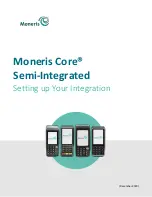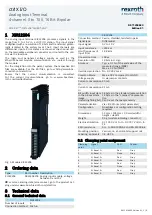
port.
(1)
An
access
point
for
data
entry
or
exit.
(2)
A
connector
on
a
device
to
which
cables
for
other
devices
such
as
display
stations
and
printers
are
attached.
Synonymous
with
socket
.
POS.
See
point-of-sale
.
POST
.
Power-on
self-test.
power-on
self-test
(POST)
.
A
series
of
diagnostic
tests
that
are
run
automatically
each
time
the
computer’s
power
is
switched
on.
problem
determination.
The
process
of
determining
the
source
of
a
problem;
for
example,
a
program
component,
machine
failure,
telecommunication
facilities,
user
or
contractor-installed
programs
or
equipment,
environmental
failure
such
as
a
power
loss,
or
user
error.
procedure.
(1)
A
set
of
related
control
statements
that
cause
one
or
more
programs
to
be
performed.
(2)
A
set
of
instructions
that
gives
a
service
representative
a
step-by-step
procedure
for
tracing
a
symptom
to
the
cause
of
failure.
processor.
In
a
computer,
a
functional
unit
that
interprets
and
executes
instructions.
(A)
(I)
protocol.
(1)
A
set
of
semantic
and
syntactic
rules
that
determine
the
behavior
of
functional
units
in
achieving
communication.
(I)
(2)
A
specification
for
the
format
and
relative
timing
of
information
exchanged
between
communicating
parties.
R
RAM.
See
random
access
memory
.
random
access
memory
(RAM).
A
computer’s
or
adapter’s
volatile
memory,
which
can
be
accessed
nonsequentially.
read.
To
acquire
or
to
interpret
data
from
a
storage
device,
from
a
data
medium,
or
from
another
source.
(I)
(A)
real-time.
(1)
Pertaining
to
the
actual
time
during
which
a
physical
process
occurs.
(2)
Pertaining
to
data
collected
concurrently
with
physical
events,
so
that
the
results
of
the
collection
operation
may
be
used
to
influence
the
sequence
of
events.
receive.
To
obtain
and
store
information
transmitted
from
a
device.
record.
A
collection
of
related
items
of
data,
treated
as
a
unit;
for
example,
in
stock
control,
each
invoice
could
constitute
one
record.
A
complete
set
of
such
records
may
form
a
file.
repeater.
A
device
that
amplifies
or
regenerates
data
signals
in
order
to
extend
the
range
of
transmission
between
devices
in
a
network.
S
SBCS.
See
single-byte
character
set
.
scanner.
A
device
that
examines
the
bar
code
on
merchandise
tickets,
credit
cards,
and
employee
badges
and
generates
analog
or
digital
signals
corresponding
to
the
bar
code.
serial
port.
On
personal
computers,
a
port
used
to
attach
devices
such
as
display
devices,
letter-quality
printers,
modems,
plotters,
and
pointing
devices
such
as
light
pens
and
mice;
it
transmits
data
one
bit
at
a
time.
Contrast
with
parallel
port
.
signal.
A
variation
of
a
physical
attribute,
used
to
convey
data.
(A)
single-byte
character
set
(SBCS).
Single-byte
character
set.
A
character
set
in
which
each
character
is
represented
by
a
one-byte
code.
Contrast
with
double-byte
character
set
.
socket.
(1)
An
opening
that
holds
something.
(2)
Synonym
for
port
.
source.
The
origin
of
any
data
involved
in
a
data
transfer.
subsystem.
A
secondary
or
subordinate
system,
usually
capable
of
operating
independently
of,
or
asynchronously
with,
a
controlling
system.
(T)
switch.
(1)
A
device
for
making
and
breaking
electrical
connections,
for
making
a
selection,
or
for
requesting
a
function
or
operation.
(2)
On
an
adapter,
a
mechanism
used
to
select
a
value
for,
enable,
or
disable
a
configurable
option
or
feature.
system.
(1)
In
data
processing,
a
collection
of
people,
machines,
and
methods
organized
to
accomplish
a
set
of
specific
functions.
(I)
(A)
See
also
data
processing
system
,
operating
system
,
and
system
unit
.
(2)
In
the
IBM
StorePlace
Distributed
Data
Services
for
OS/2,
a
group
of
nodes
for
which
files
are
managed.
system
board.
In
a
system
unit,
the
main
circuit
board
that
supports
a
variety
of
basic
system
devices,
such
as
a
keyboard
or
a
mouse,
and
provides
other
basic
system
functions.
system
configuration.
A
process
that
specifies
the
devices
and
programs
that
form
a
particular
data
processing
system.
system
unit.
(1)
A
part
of
a
computer
that
contains
the
processing
unit
and
may
contain
devices
such
as
disk
and
diskette
drives.
(2)
In
an
IBM
Personal
Computer,
the
unit
that
contains
the
processor
circuitry,
read-only
Updated
October,
2008
134
SurePOS
500
Model
514
Summary of Contents for 4851 514
Page 2: ......
Page 8: ...Updated October 2008 vi SurePOS 500 Model 514...
Page 12: ...Updated October 2008 x SurePOS 500 Model 514...
Page 16: ...Updated October 2008 xiv SurePOS 500 Model 514...
Page 20: ...Figure 2 Serial number location Updated October 2008 4 SurePOS 500 Model 514...
Page 32: ...Installing the IBM SurePOS 500 Model 514 Updated October 2008 16 SurePOS 500 Model 514...
Page 64: ...Installing additional peripheral devices Updated October 2008 48 SurePOS 500 Model 514...
Page 68: ...Updated October 2008 52 SurePOS 500 Model 514...
Page 102: ...Updated October 2008 86 SurePOS 500 Model 514...
Page 138: ...Updated October 2008 122 SurePOS 500 Model 514...
Page 143: ...IBM IBM GA27 4004 GA27 4004 Updated October 2008 Appendix D Safety information 127...
Page 152: ...Updated October 2008 136 SurePOS 500 Model 514...
Page 156: ...Updated October 2008 140 SurePOS 500 Model 514...
Page 158: ...Updated October 2008 142 SurePOS 500 Model 514...
Page 161: ......
Page 162: ...Updated October 2008 GA27 4361 01...













































